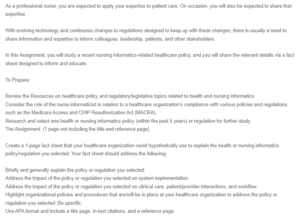Health Informatics Policy – HIPAA Fact Sheet
Policy Overview
The Health Insurance Portability and Accountability Act (HIPAA) is a significant policy in the healthcare industry, enacted in 1996, with the primary goal of protecting patients’ sensitive health information. HIPAA establishes standards for the privacy and security of electronic health information and mandates the use of electronic health records (EHRs) to maintain patient data’s confidentiality, integrity, and availability (McGonigle & Mastrian, 2017). It also sets regulations for how healthcare organizations and their business associates handle and share protected health information (PHI).
Impact on System Implementation
Healthcare organizations must invest significantly in secure EHR systems and data infrastructure, ensuring compliance with stringent privacy and security requirements. Feinberg et al. (2019) highlight that this can be financially burdensome, demanding resources for technology, staff training, and regular audits. The need for robust encryption, access controls, and audit trails adds complexity to system design. However, HIPAA compliance is crucial for maintaining patient trust and data security. Literature from Feinberg et al. (2019) reveals that it also fosters the shift towards efficient electronic record-keeping systems, promoting standardized healthcare practices, even though its implementation can be challenging.
Impact on Clinical Care, Patient/Provider Interactions, and Workflow
HIPAA-compliant EHRs make patient records easily accessible to authorized healthcare providers. This ensures quick access to essential patient data, improving clinical decision-making. Moreover, HIPAA prioritizes patient privacy, as highlighted in the literature by Wahezi et al. (2021). This enhances trust and communication between patients and healthcare providers, as patients are more likely to share sensitive information when they know their data is protected. While initial implementation can be challenging, HIPAA-compliant systems often improve workflow efficiency. Studies by Wahezi et al. (2021) show that streamlined data access, electronic record-keeping, and interoperability between healthcare systems contribute to more efficient care delivery.
Organizational Policies and Procedures
Our healthcare organization has established stringent privacy policies in compliance with HIPAA. As indicated by Choi & Williams (2022), these policies guide staff in handling patient information, including the minimum necessary standard, which ensures that only authorized personnel have access to patient records. We employ state-of-the-art security measures to protect patient data. This includes encryption for data in transit and at rest, user authentication, access controls, and regular security audits.
Additionally, our organization provides ongoing training and education to staff members to ensure they understand the importance of HIPAA compliance. This includes regular updates on policy changes and best practices for data security. Consistently, in the event of a data breach or security incident, we have a well-defined incident response plan in place. Choi & Williams (2022), this includes notifying affected individuals, reporting the breach to the appropriate authorities, and preventing similar incidents. Moreover, when working with third-party vendors, we establish strict business associate agreements to ensure they adhere to HIPAA regulations when handling patient information.
Conclusion
In conclusion, HIPAA is a critical policy that impacts healthcare organizations in multiple ways. While it poses challenges regarding system implementation and ongoing compliance efforts, it significantly enhances the quality of clinical care, patient-provider interactions, and workflow efficiency. Our healthcare organization is dedicated to upholding these standards and has a range of policies and procedures to ensure HIPAA compliance and safeguard patient information.
References
Choi, Y. B., & Williams, C. E. (2022). A HIPAA security and privacy compliance audit and risk assessment mitigation approach. In Research Anthology on Securing Medical Systems and Records (pp. 706-725). IGI Global. DOI: 10.4018/978-1-6684-6311-6.ch032
Feinberg, J., Shaw, S., Kashyap, N., Illuzzi, J., Campbell, K., Hsiao, A. L., & Pettker, C. M. (2019). Evaluating the impact of a new smartphone texting tool on patient care in obstetrics, an emergent healthcare setting. Applied Clinical Informatics, 10(05), 879-887. DOI: 10.1055/s-0039-1700868
McGonigle, D., & Mastrian, K. G. (2017). Nursing informatics and the foundation of knowledge (4th ed.). Burlington, MA: Jones & Bartlett Learning.
Wahezi, S. E., Kohan, L. R., Spektor, B., Brancolini, S., Emerick, T., Fronterhouse, J. M., & Kaye, A. D. (2021). Telemedicine and current clinical practice trends in the COVID-19 pandemic. Best Practice & Research Clinical Anaesthesiology, 35(3), 307-319. https://doi.org/10.1016/j.bpa.2020.11.005
ORDER A PLAGIARISM-FREE PAPER HERE
We’ll write everything from scratch
Question
As a professional nurse, you are expected to apply your expertise to patient care. On occasion, you will also be expected to share that expertise.

Health Informatics Policy – HIPAA Fact Sheet
With evolving technology and continuous changes to regulations designed to keep up with these changes, there is usually a need to share information and expertise to inform colleagues, leadership, patients, and other stakeholders.
In this Assignment, you will study a recent nursing informatics-related healthcare policy, and you will share the relevant details via a fact sheet designed to inform and educate.
To Prepare:
Review the Resources on healthcare policy and regulatory/legislative topics related to health and nursing informatics.
Consider the role of the nurse informaticist in relation to a healthcare organization’s compliance with various policies and regulations, such as the Medicare Access and CHIP Reauthorization Act (MACRA).
Research and select one health or nursing informatics policy (within the past 5 years) or regulation for further study.
The Assignment: (1 page not including the title and reference page)
Create a 1-page fact sheet that your healthcare organization could hypothetically use to explain the health or nursing informatics policy/regulation you selected. Your fact sheet should address the following:
Briefly and generally explain the policy or regulation you selected.
Address the impact of the policy or regulation you selected on system implementation.
Address the impact of the policy or regulation you selected on clinical care, patient/provider interactions, and workflow.
Highlight organizational policies and procedures that are/will be in place at your healthcare organization to address the policy or regulation you selected. Be specific.
Use APA format and include a title page, in-text citations, and a reference page.

